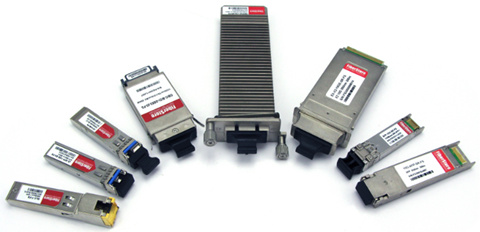In data communication, the seamless transfer of high-bandwidth data between network devices is paramount. At the heart of this efficiency lies the Small Form-Factor Pluggable Plus Multi-Source Agreement (SFP+ MSA), a standardized framework shaping the design and functionality of optical transceivers. Explore with us the transformative role of SFP+ MSA, a driving force in standardizing interoperability for optical transceivers beyond mere specification.
Navigating the Impact of SFP+ MSA in Optical Transceivers
Definition and Expansion of MSA
MSA, an abbreviation for Multi-Source Agreement, is a protocol that enables different manufacturers to produce optical module products with similar basic functionalities and interoperability. The interface types of optical modules from various manufacturers were once diverse. To address the lack of interoperability, multiple manufacturers joined forces to create an organization dedicated to standardizing specifications for the interface types, installation, and functionalities of optical modules. MSA emerged as a supplement to IEEE standards. For optical modules, the MSA standard not only defines their physical dimensions but also outlines their electrical and optical interfaces, creating a comprehensive standard for optical modules.
Significance of SFP+ MSA in Networking Standards
Due to the MSA standard defining the physical dimensions and interface types of optical modules, suppliers strictly adhere to MSA standards during system design to ensure interoperability and interchangeability between optical modules. For end-users, the MSA standard holds crucial significance for two main reasons:
Firstly, the MSA standard offers users a variety of choices. As long as an optical module complies with the MSA standard and demonstrates good compatibility, customers can choose any optical module needed from any third-party supplier.
Secondly, concerning costs, the MSA standard, to some extent, prevents the optical module market from being monopolized by certain major manufacturers. This situation contributes to lowering the network construction costs for end-users.

Exploring the Key Features of SFP+ MSA
Unlocking the potential of SFP+ MSA involves understanding its key features. This section will explore the small form-factor design, high-speed data transmission capabilities, interoperability across vendors, compatibility with various fiber types, and the importance of compliance and certification. These features collectively contribute to the versatility and efficiency of SFP+ modules, redefining connectivity standards in modern networking environments.
Small Form-Factor Design
The compact form factor of SFP+ modules enables high port density in network equipment, a crucial aspect for contemporary data centers aiming to save rack space and optimize spatial layouts. Additionally, this design also supports hot-swapping, providing flexibility in network management.
High-Speed Data Transmission
SFP+ modules are designed to handle high-speed data transmission, with data rates exceeding 10 Gbps and reaching up to 25 Gbps. This high bandwidth is essential for applications demanding swift and reliable data transfer, such as in high-performance computing and data center interconnects.
Interoperability Across Vendors
The key goal of the SFP+ MSA is to ensure interoperability among modules from different vendors. This standardization allows network administrators to mix and match SFP+ modules from various manufacturers without compatibility concerns, promoting a vendor-neutral environment.
Compatibility with Various Fiber Types
Support various types of optical fibers, including single-mode and multi-mode fibers. This versatility in fiber compatibility enhances the adaptability of SFP+ modules to different networking scenarios and infrastructures.
Compliance and Certification
SFP+ modules undergo rigorous testing to ensure compliance with standards such as MSA, IEEE, GR-xx-CORE, ITU-T, guaranteeing reliable performance and interoperability in various aspects.
Unlocking Excellence in SFP+ MSA Advantages
SFP+ MSA brings several advantages to network infrastructures.
Flexible and Scalable Networks
The standardization provided by SFP+ MSA enhances network flexibility by allowing the deployment of modules from different manufacturers. It also facilitates the scalability of networks. As data demands increase, administrators can easily upgrade network capacities by adding or replacing SFP+ modules, ensuring that the infrastructure can evolve with changing requirements.
Seamless Integration in Diverse Environments
SFP+ modules find applications in diverse environments, ranging from enterprise data centers to telecommunications networks. The standardization ensures these modules integrate seamlessly, providing consistent performance across various settings.
Cost-Efficiency in Network Deployments
The interoperability of SFP+ modules reduces dependence on a single vendor, fostering a competitive market that can lead to cost savings for network infrastructure deployments. Administrators can select modules based on specific requirements. This flexibility is crucial for network administrators seeking cost-effective solutions without compromising performance.
Unleashing the Potential of SFP+ Modules in Applications
In the previous discussion, we covered aspects of SFP+ concerning MSA standards. Now, let’s unveil the applications of SFP+ in various environments. From data centers to telecommunications networks, the presence of SFP+ modules is ubiquitous.
Data Center Connectivity
SFP+ modules are essential for data center connectivity, providing high-speed links that ensure efficient communication among servers, storage devices, and networking equipment.
High-Performance Computing (HPC)
In the realm of high-performance computing, SFP+ modules support the high-speed data transmission required for parallel computing and scientific simulations.

Telecom and Network Infrastructure
SFP+ modules are integral to telecommunications networks and general infrastructure, serving as the foundation for dependable and high-performance data transmission.
Conclusion
In summary, SFP+ MSA serves as a cornerstone in the realm of optical transceivers, providing standardized specifications that ensure interoperability, versatility, and performance. By embracing the standards set by SFP+ MSA, the networking industry can continue to build robust, efficient, and future-ready infrastructures that meet the demands of modern data transmission.

-18.jpg)
-17.jpg)

